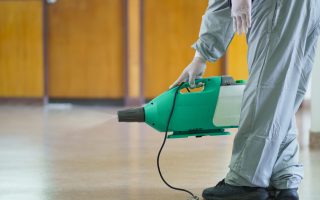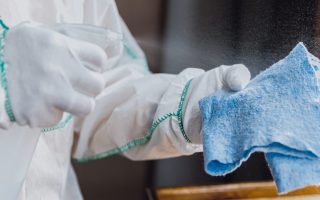The importance of a deep clean in schools
The cleaning standards in a school are directly linked to the wellbeing and performance of pupils and staff. Infections of all kinds spread rapidly in schools, especially where hygiene standards are low, and this has a significant impact on academic results.
In our recent blog ‘How a Clean School Can Reduce Absences‘, we referred to a report by the Department of Education, which stated that 78.7% of students with no recorded absences achieved at least 5 GCSE passes. However, among students with 5-10 reported absences, pass rates fell to 52.8%.
As the education sector recovers from the far-reaching effects of the pandemic on children’s learning and confidence levels, it’s more important than ever to drive down pupil and staff absence in schools.
Hygiene isn’t the only factor affecting wellbeing and productivity in schools. It’s also important to maintain the look and feel of a school so that pupils and staff can work comfortably and effectively – we’ll demonstrate this later with the example of school washrooms.
Effective cleaning also maintains and protects the assets in a school building, so there is less expense and wastage in the long run. As schools can spend hundreds of pounds per week on supply fees to cover teaching staff on sick absence.
Guidance on the UK Government website is very clear that a school’s cleaning regime must include deep cleaning as standard. The article on healthcare protection in schools and other childcare facilities mentioned that “essential elements of a comprehensive cleaning contract include daily, weekly and periodic [i.e. deep] cleaning schedules.” This is why employing contract cleaners for schools is imperative.”
Deep cleaning is not an optional extra or an excuse for cutting corners in the regular cleaning regime. Rather it resets the required cleaning standard, so that the regular cleaning can maintain it as far as possible throughout the school year.
School deep cleaning checklist
A school should write a specification listing daily, weekly and periodic/deep cleaning tasks, and work with their cleaning and education facility management provider to ensure the specification is practical and efficient. Here we’ll outline some priorities for a typical school deep cleaning specification. These lists are not exhaustive, and it should be assumed that standard daily and weekly tasks apply to deep cleans too.
Classrooms:
- Desks: don’t just wipe around computer keyboards as usual, lift them and clean the whole desk.
- Remove chewing gum from the furniture. This might be a day’s work for one operative, so allocate the time.
- Clean windows and internal glass. Site-based operatives may only manage cleaning to hand-height, so an outsourced window cleaning company may be required.
- Arrange a carpet clean, or use a small scrubbing machine to bring hard floors back up to standard.
- Chair legs tend to gather dirt and scuff marks, so these should be cleaned where possible.
- Remember to clean dirt and scuff marks from the kickplates on the classroom doors.
Toilets:
Toilet areas are the main focus of scrutiny when it comes to hygiene in any building, so extra investment will pay off here. According to a global survey by Unilever, 90% of school children who took part said they had been affected emotionally or physically by the state of their school toilets. 30% admitted to poor concentration in class because of avoiding using the toilets, and 12% said they wouldn’t eat or drink at school for that reason.

The goal is to make the school toilets a place that no-one has reservations about visiting. The deep clean is the time to give all units a thorough, all-round, and heavy-duty clean. As well as the usual cleaning tasks, consider as many of these suggestions as possible.
- Include difficult-to-reach parts of toilets or sinks in the overall clean.
- Wipe walls/tiling and cubicle doors.
- Don’t just mop the floors as usual; use a small scrubbing machine to bring them back up to standard.
- De-scale toilets and sinks.
- Remove chewing gum and (where possible) graffiti.
- Remember to clean high level areas like windowsills or light fittings where dust and germs can gather over time.
Entrance and hallways
These areas are more on display to pupils, staff and visitors than perhaps any other part of the school, so they should be the most visibly clean. The deep clean is the opportunity to put the shine back into these high-traffic areas.
- Polish the glass in entrance doors, and wipe down the handles at the education reception area: these are a visitor’s first impression of the school.
- Pay close attention to fixtures and fittings in entrance halls, corridors or landings. This could include furniture, display cases, or other items that contribute to the school’s image.
- Skirting boards should be free of scuff marks and grime.
- Wipe down bannisters and railings. Remember, children will often grab the lowest or highest banister rail on a staircase, and even swing around it, so these need extra attention.
- Renovating the floors in entrance halls and corridors each year makes possibly the most striking difference to the look and feel of the school. The equipment and materials can be included in the contract, or charged separately on demand. Either way, a deep clean specification should include an annual strip, re-seal and polish of the floors.
Gym and hall
These are densely occupied, with plenty of touchpoints, and therefore another hygiene hotspot.
- With a high level of wear-and-tear, the floor areas will need at least an annual strip, re-seal and polish.
- Also consider a full clean of gym equipment, climbing bars, benches or other furniture.
-

Deep Cleaning Checklist for Schools
Kitchen and canteen areas
As a rule, the responsibility for kitchen and catering equipment cleaning lies solely with the catering staff, who will clean them to industry-standard health and safety protocols. However, the canteen area is likely to be included in the standard cleaning specification. Naturally, a high-traffic area where food is consumed is among a school’s biggest infection risk areas.
- Thoroughly clean all canteen floor areas and furniture, as food fragments will be a hotspot for bacteria to breed.
- Pay particular attention to chair and table legs, where grime collects.
- Seriously consider the floor renovation discussed in the sections above.
- Ensure you have an effective plan for waste management in schools in place
Staffroom and offices
It is worth remembering that even if these are no-go areas for pupils, the high concentration of staff (who have been in contact with pupils anyway) leaves them just as vulnerable to harmful bacteria.
- Pay close attention to any kitchenette/food prep areas, including fridges and cupboards
- Major touchpoints (apart from door handles, light switches and the like) include the kettle or water urn, kitchen taps, and fridge and cupboard doors. These should be included in the daily spec, and certainly as part of a deep clean.
- Thoroughly clean desks and booths, including underneath keyboards or phones.
- Staff rooms tend to feature a lot of soft furnishings like sofas and easy chairs. If possible, arrange for deep cleaning of soft furnishings too.
How is a deep clean different to a normal clean?
High cleaning standards at a school shouldn’t have to ‘wait’ for the next scheduled deep clean. A well-managed daily clean should maintain a good overall standard, prioritising the most important areas without neglecting the others.
The deep clean plays a supporting role by restoring an optimal standard, so that the subsequent daily cleaning can reasonably maintain it throughout the school year.
A deep clean includes the same tasks as the daily clean, but with enhanced detail and thoroughness. Attention should be given to secondary or specialist areas like high-level dusting, hard-to-reach parts, or machine scrubbing of a hard floor.
Post pandemic, a daily touchpoint cleaning schedule is a must. This means cleaning and sanitisation of door handles, light switches, taps/flushes, desks and more. Depending on the contract, this may be done by a janitor during the school day.
It’s common for a janitor to be working on touchpoints during lessons, ready for break and lunchtimes. The daytime tasks help to balance out the evening tasks to some degree, although some extra financing may be required to maintain the day shift.
How often should you deep clean a school?
Depending on the contract, deep cleaning is either scheduled for the summer holidays, or spread over the various holiday periods throughout the school year. A school should work with its cleaning provider to build the schedule that best suits the school’s calendar and its site-specific needs.
From the outset, a school cleaning contract should be clear about which deep cleaning tasks are included in the overall cost. There may be extra charges for certain specialist or unexpected tasks that may involve extra machinery or outsourced skills.
Deep cleaning is another good reason for outsourcing school cleaning services. A professional cleaning contractor is highly recommended if a school is to best fulfil its health and safety obligations, protect its pupils and staff from infections, and minimise absences and their consequences. For example, our washroom services protect pupils and staff from infections and minimise absences and their consequences.
Professional cleaning also preserves the image of the school and its status as a quality working environment for everyone. It extends the life of a building’s fabric, fixtures and fittings by maintaining them with care. Cleaning providers will have strategies to make a school a more sustainable environment, and they may even reduce its overheads.
Above all, when a school outsources its cleaning to the experts, it allows its staff to focus on its mission to shape future generations through education.
As we noted, deep cleaning is not a justification for cleaning compromises throughout the school year. It is part of an ongoing strategy for a consistent standard of cleanliness and hygiene, creating a thriving learning environment.
At Samsic UK, we have 35 years of school cleaning expertise to offer. Contact us today for an experienced perspective on school cleaning.









